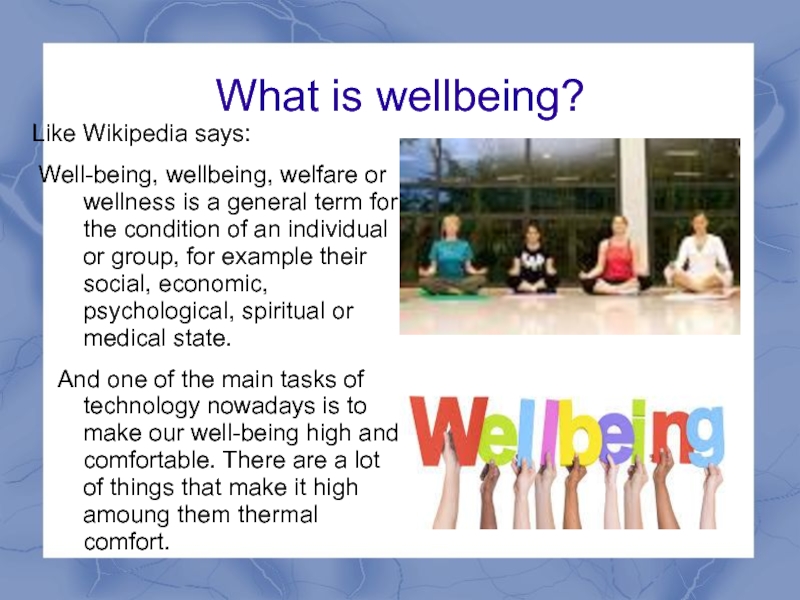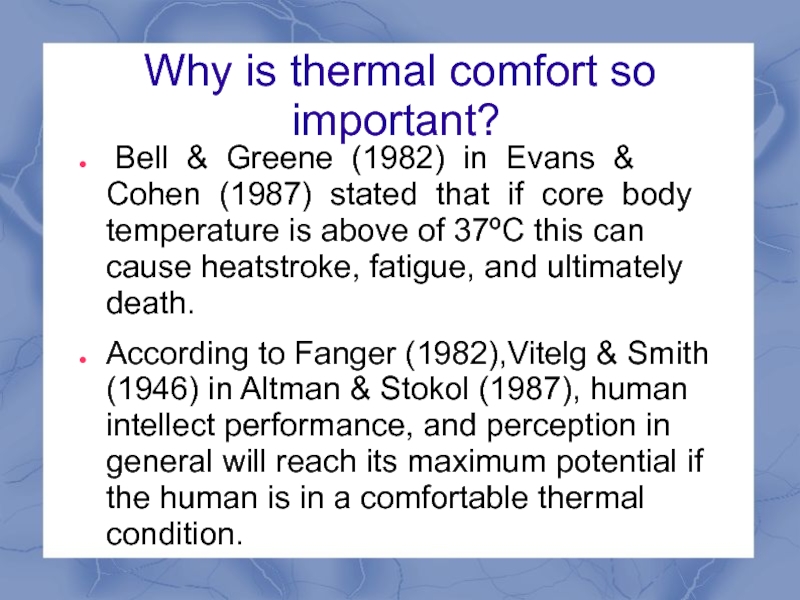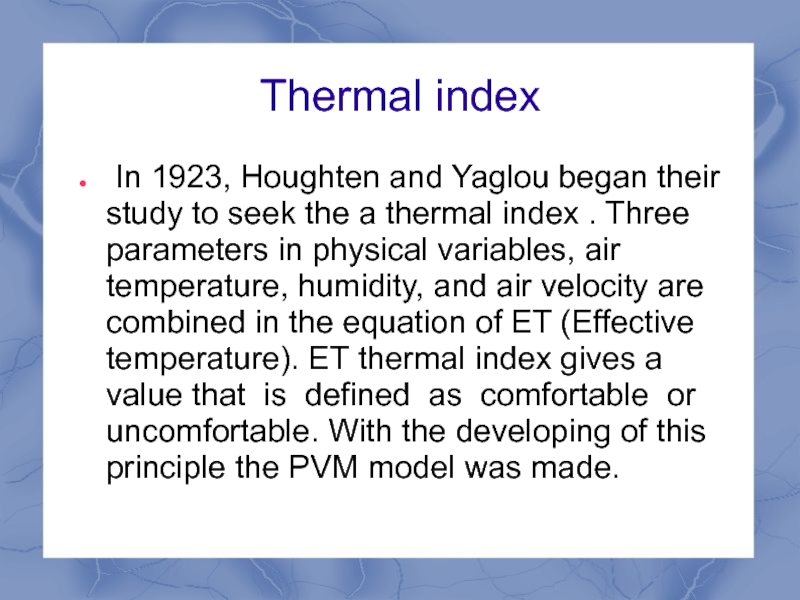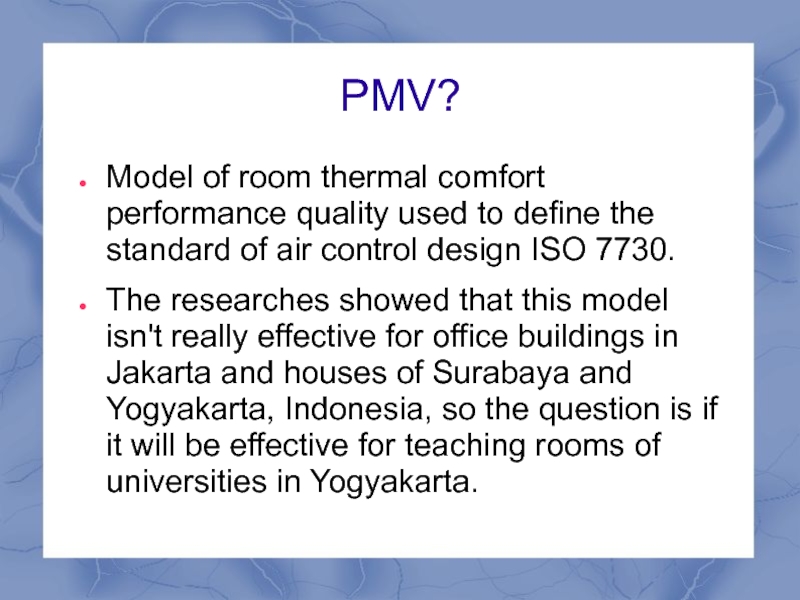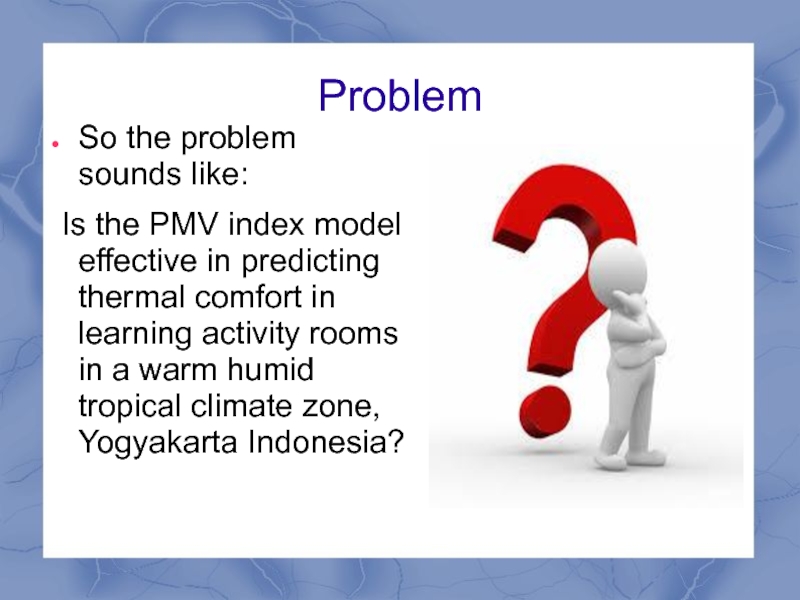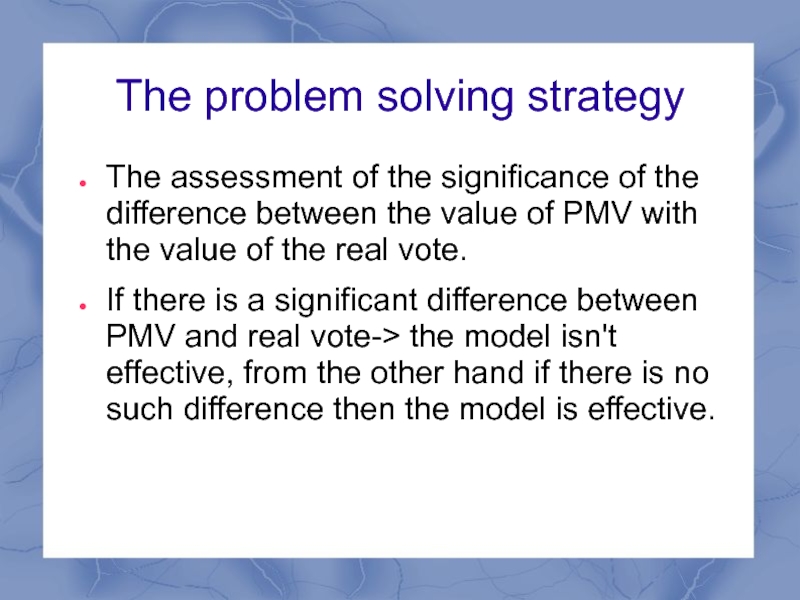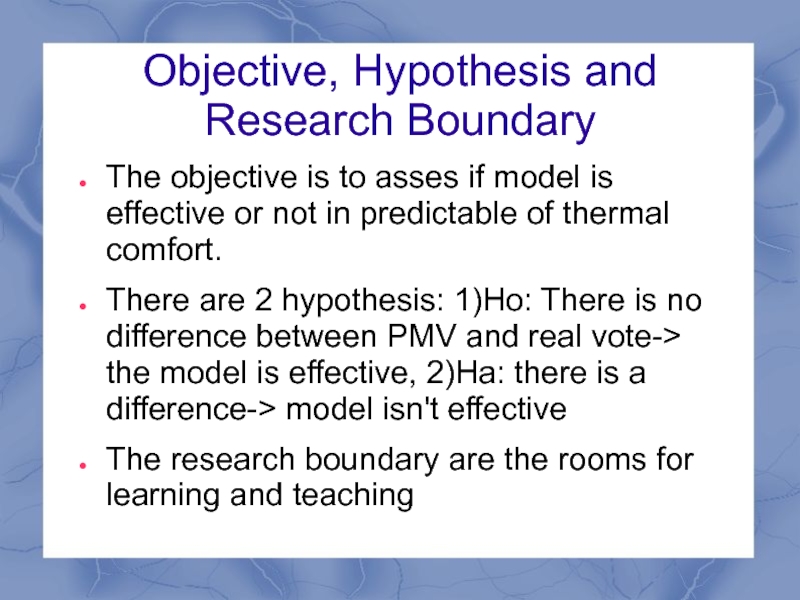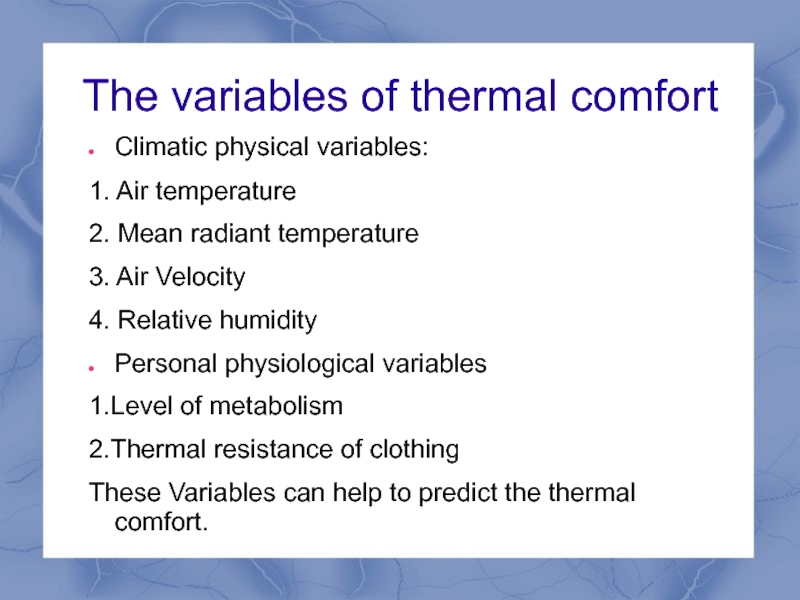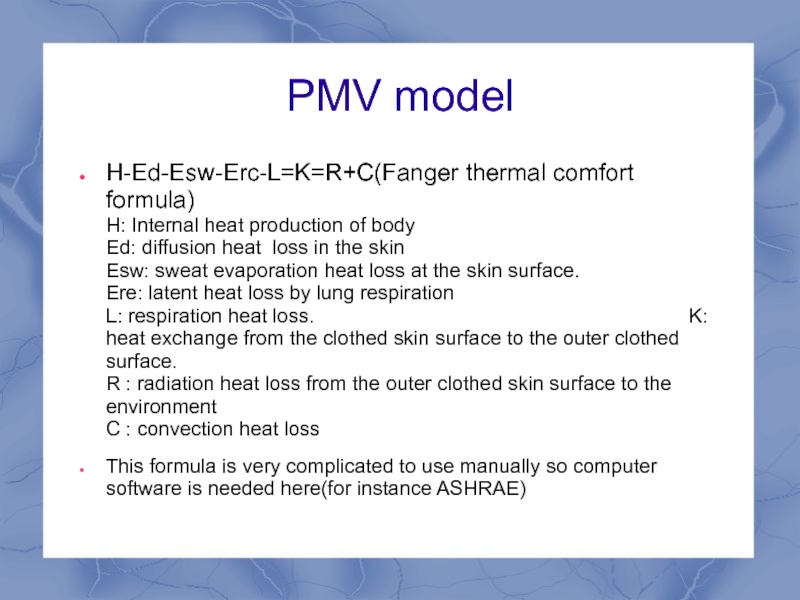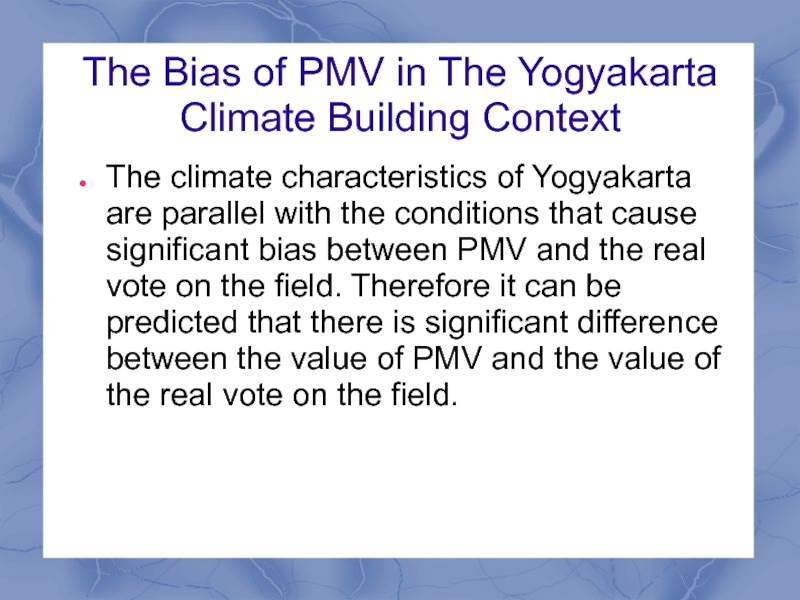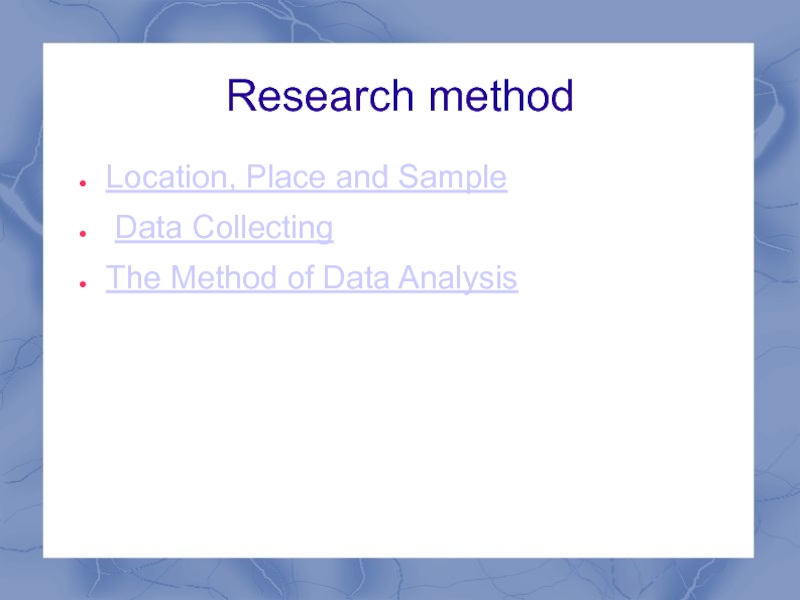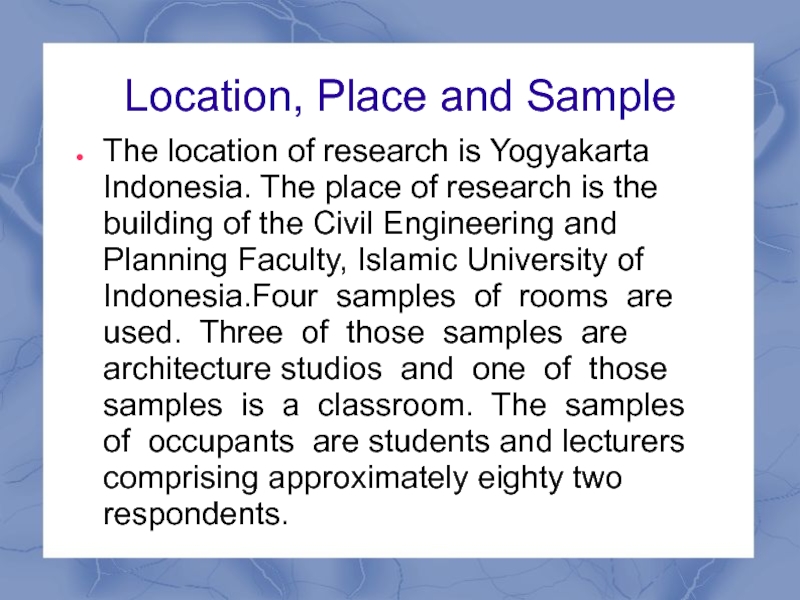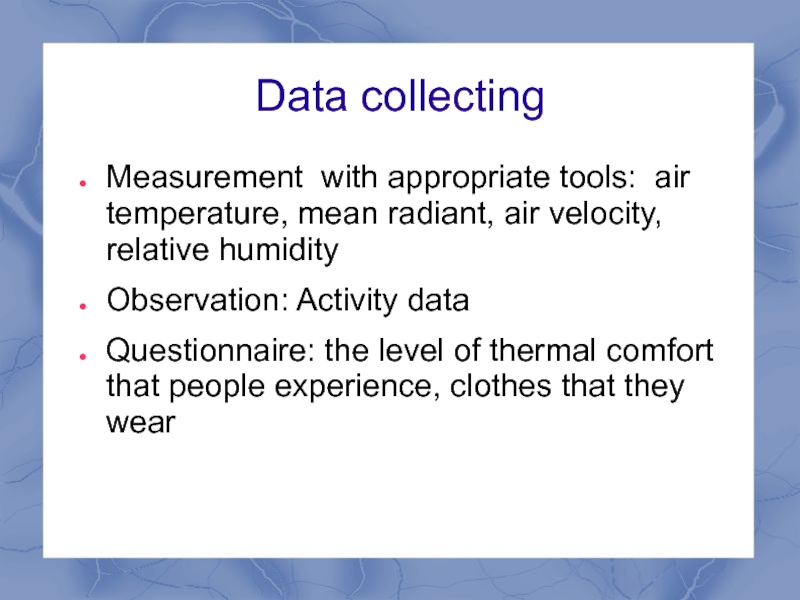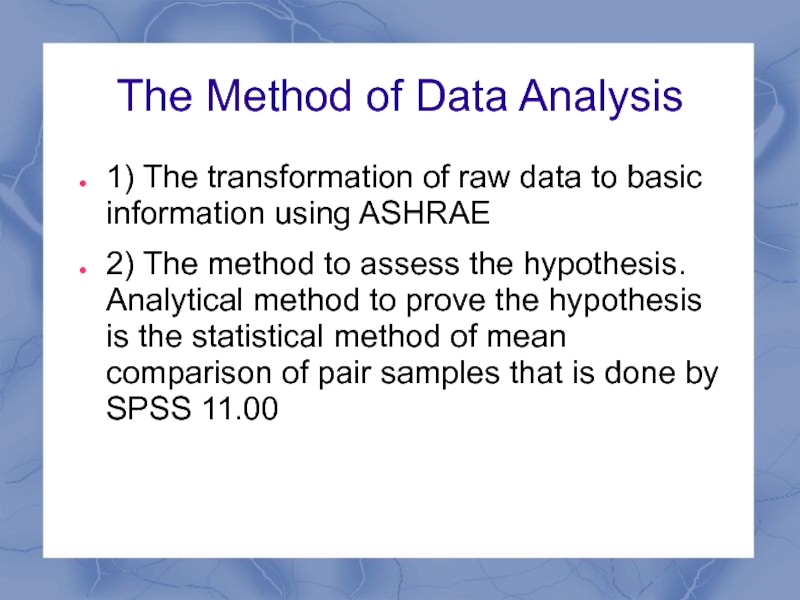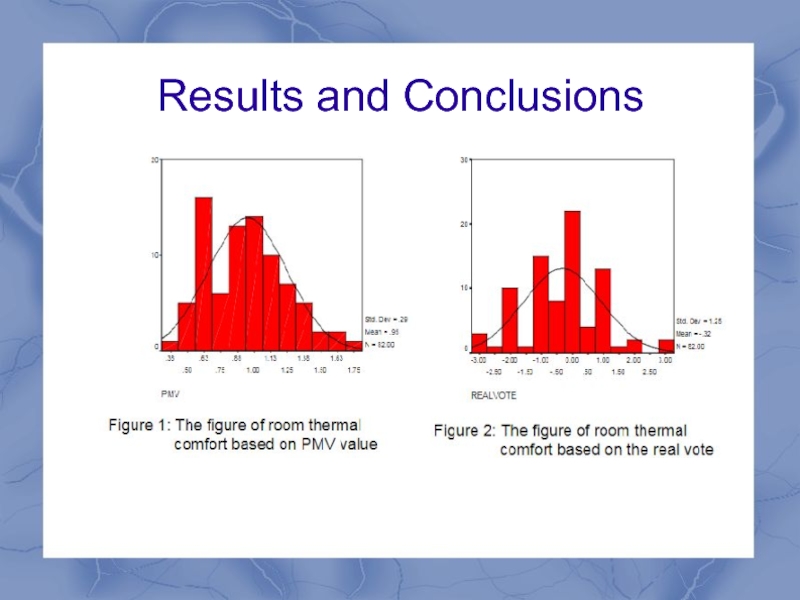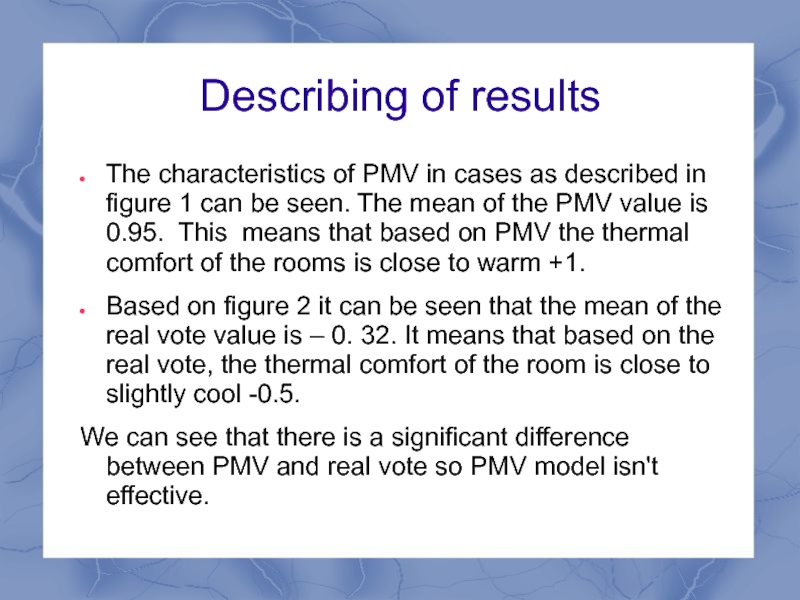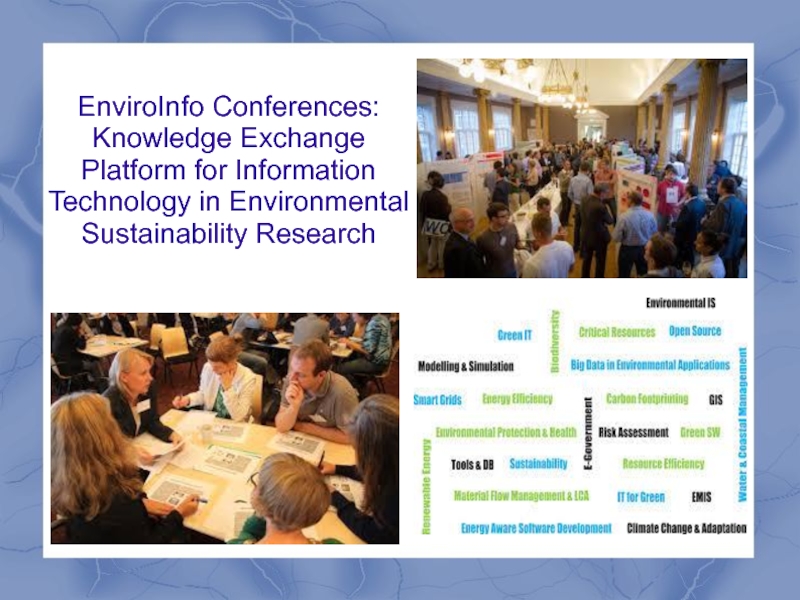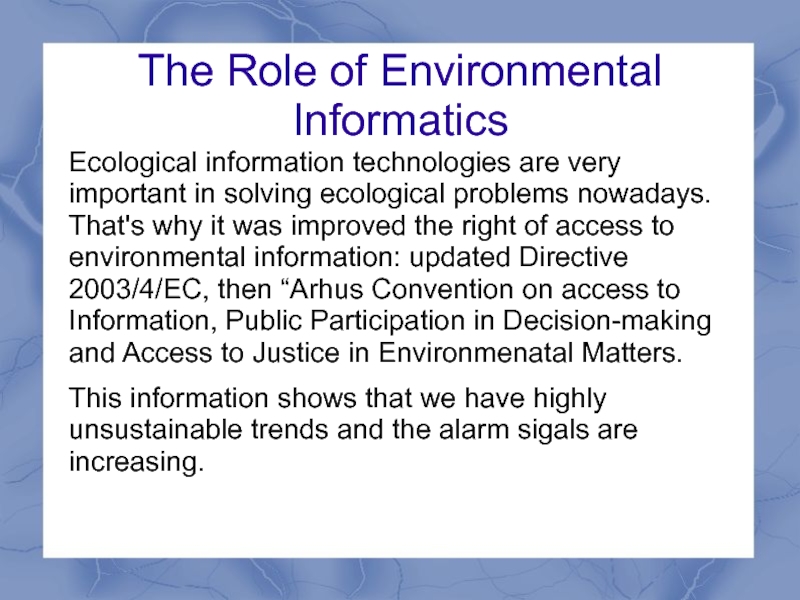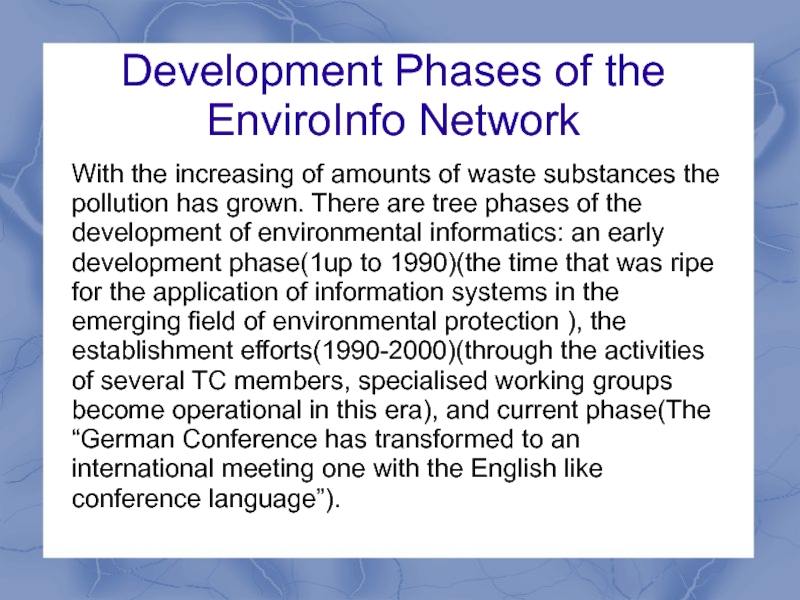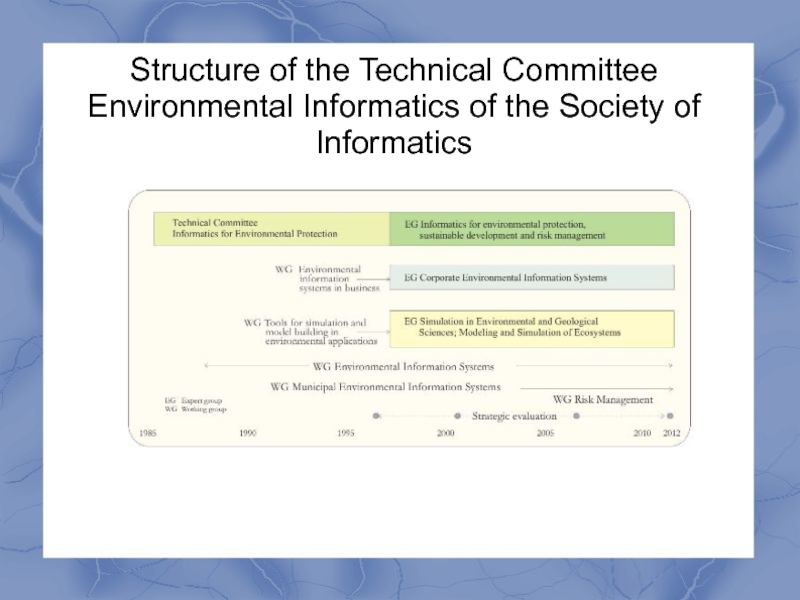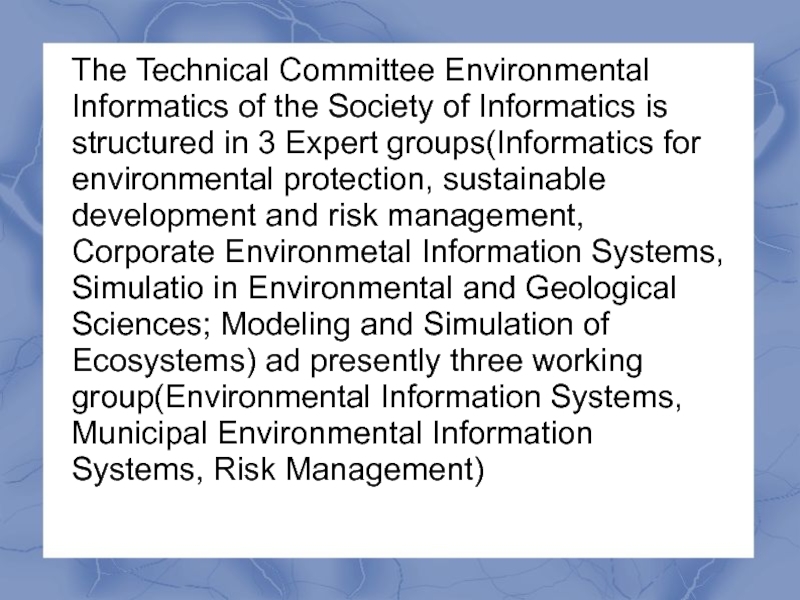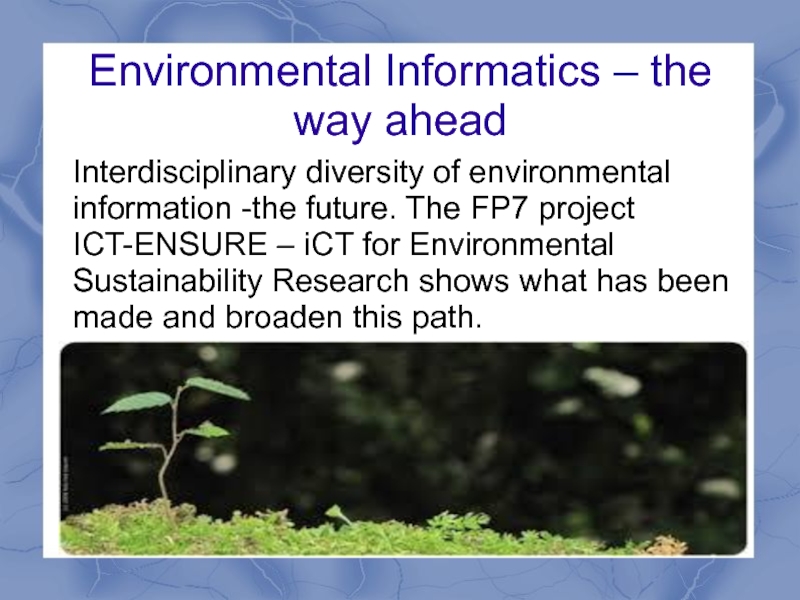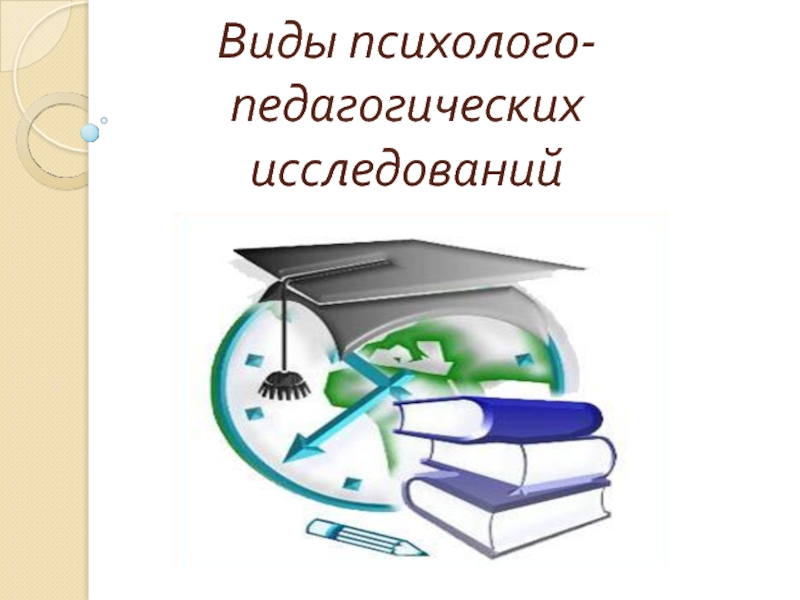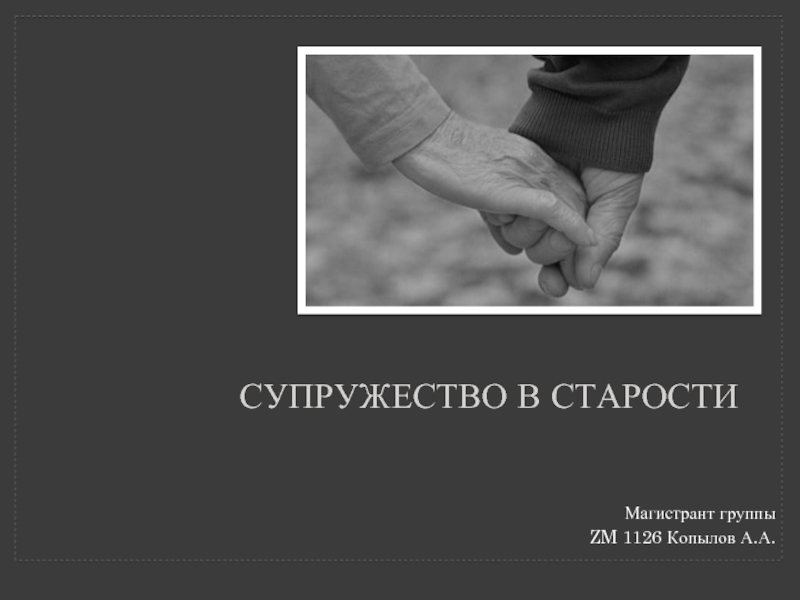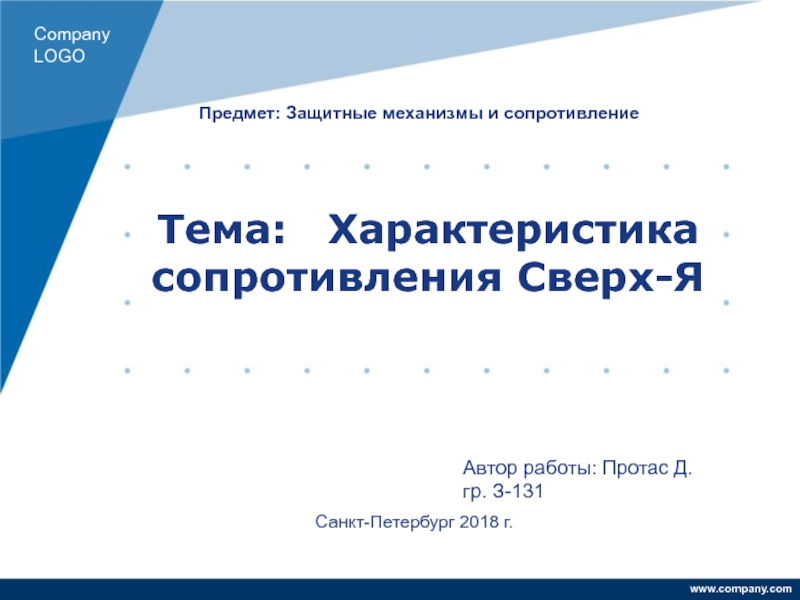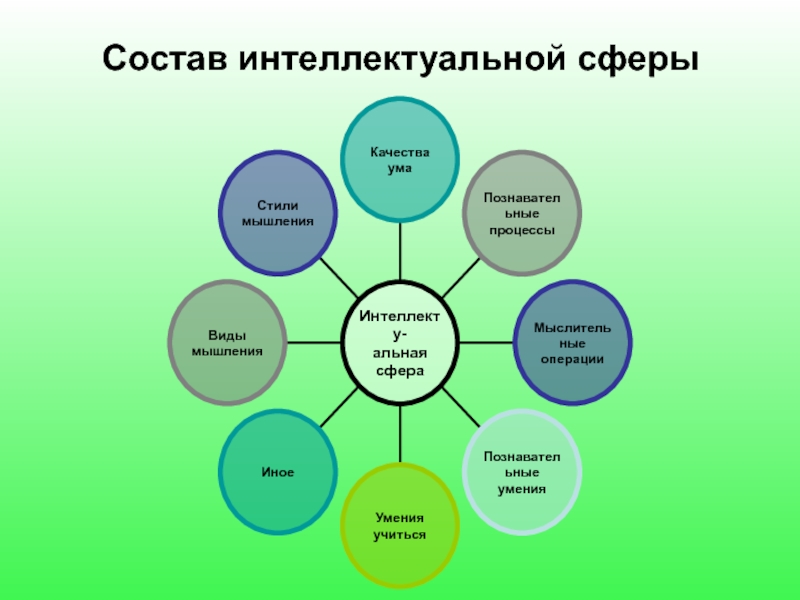a general term for the condition of an individual or group, for example their social, economic, psychological, spiritual or medical state.
And one of the main tasks of technology nowadays is to make our well-being high and comfortable. There are a lot of things that make it high amoung them thermal comfort.
- Главная
- Разное
- Дизайн
- Бизнес и предпринимательство
- Аналитика
- Образование
- Развлечения
- Красота и здоровье
- Финансы
- Государство
- Путешествия
- Спорт
- Недвижимость
- Армия
- Графика
- Культурология
- Еда и кулинария
- Лингвистика
- Английский язык
- Астрономия
- Алгебра
- Биология
- География
- Детские презентации
- Информатика
- История
- Литература
- Маркетинг
- Математика
- Медицина
- Менеджмент
- Музыка
- МХК
- Немецкий язык
- ОБЖ
- Обществознание
- Окружающий мир
- Педагогика
- Русский язык
- Технология
- Физика
- Философия
- Химия
- Шаблоны, картинки для презентаций
- Экология
- Экономика
- Юриспруденция
Wellbeing презентация
Содержание
- 1. Wellbeing
- 2. Why is thermal comfort so important?
- 3. Thermal index In 1923, Houghten and
- 4. PMV? Model of room thermal comfort performance
- 5. Problem So the problem sounds like:
- 6. The problem solving strategy The assessment
- 7. Objective, Hypothesis and Research Boundary The
- 8. The variables of thermal comfort Climatic
- 9. PMV model H-Ed-Esw-Erc-L=K=R+C(Fanger thermal comfort formula) H:
- 10. The Bias of PMV in The Yogyakarta
- 11. Research method Location, Place and Sample Data Collecting The Method of Data Analysis
- 12. Location, Place and Sample The location of
- 13. Data collecting Measurement with appropriate tools: air
- 14. The Method of Data Analysis 1) The
- 15. Results and Conclusions
- 16. Describing of results The characteristics of
- 17. EnviroInfo Conferences: Knowledge Exchange Platform for Information Technology in Environmental Sustainability Research
- 18. The Role of Environmental Informatics Ecological information
- 19. Development Phases of the EnviroInfo Network
- 20. Structure of the Technical Committee Environmental Informatics of the Society of Informatics
- 21. The Technical Committee Environmental Informatics of the
- 22. Environmental Informatics – the way ahead
Слайд 2Why is thermal comfort so important?
Bell & Greene (1982) in
Evans & Cohen (1987) stated that if core body temperature is above of 37ºC this can cause heatstroke, fatigue, and ultimately death.
According to Fanger (1982),Vitelg & Smith (1946) in Altman & Stokol (1987), human intellect performance, and perception in general will reach its maximum potential if the human is in a comfortable thermal condition.
According to Fanger (1982),Vitelg & Smith (1946) in Altman & Stokol (1987), human intellect performance, and perception in general will reach its maximum potential if the human is in a comfortable thermal condition.
Слайд 3Thermal index
In 1923, Houghten and Yaglou began their study to
seek the a thermal index . Three parameters in physical variables, air temperature, humidity, and air velocity are combined in the equation of ET (Effective temperature). ET thermal index gives a value that is defined as comfortable or uncomfortable. With the developing of this principle the PVM model was made.
Слайд 4PMV?
Model of room thermal comfort performance quality used to define the
standard of air control design ISO 7730.
The researches showed that this model isn't really effective for office buildings in Jakarta and houses of Surabaya and Yogyakarta, Indonesia, so the question is if it will be effective for teaching rooms of universities in Yogyakarta.
The researches showed that this model isn't really effective for office buildings in Jakarta and houses of Surabaya and Yogyakarta, Indonesia, so the question is if it will be effective for teaching rooms of universities in Yogyakarta.
Слайд 5Problem
So the problem sounds like:
Is the PMV index model effective
in predicting thermal comfort in learning activity rooms in a warm humid tropical climate zone, Yogyakarta Indonesia?
Слайд 6The problem solving strategy
The assessment of the significance of the
difference between the value of PMV with the value of the real vote.
If there is a significant difference between PMV and real vote-> the model isn't effective, from the other hand if there is no such difference then the model is effective.
If there is a significant difference between PMV and real vote-> the model isn't effective, from the other hand if there is no such difference then the model is effective.
Слайд 7Objective, Hypothesis and Research Boundary
The objective is to asses if
model is effective or not in predictable of thermal comfort.
There are 2 hypothesis: 1)Ho: There is no difference between PMV and real vote-> the model is effective, 2)Ha: there is a difference-> model isn't effective
The research boundary are the rooms for learning and teaching
There are 2 hypothesis: 1)Ho: There is no difference between PMV and real vote-> the model is effective, 2)Ha: there is a difference-> model isn't effective
The research boundary are the rooms for learning and teaching
Слайд 8The variables of thermal comfort
Climatic physical variables:
1. Air temperature
2. Mean
radiant temperature
3. Air Velocity
4. Relative humidity
Personal physiological variables
1.Level of metabolism
2.Thermal resistance of clothing
These Variables can help to predict the thermal comfort.
3. Air Velocity
4. Relative humidity
Personal physiological variables
1.Level of metabolism
2.Thermal resistance of clothing
These Variables can help to predict the thermal comfort.
Слайд 9PMV model
H-Ed-Esw-Erc-L=K=R+C(Fanger thermal comfort formula) H: Internal heat production of body
Ed: diffusion heat loss in the skin Esw: sweat evaporation heat loss at the skin surface. Ere: latent heat loss by lung respiration L: respiration heat loss. K: heat exchange from the clothed skin surface to the outer clothed surface. R : radiation heat loss from the outer clothed skin surface to the environment C : convection heat loss
This formula is very complicated to use manually so computer software is needed here(for instance ASHRAE)
This formula is very complicated to use manually so computer software is needed here(for instance ASHRAE)
Слайд 10The Bias of PMV in The Yogyakarta Climate Building Context
The
climate characteristics of Yogyakarta are parallel with the conditions that cause significant bias between PMV and the real vote on the field. Therefore it can be predicted that there is significant difference between the value of PMV and the value of the real vote on the field.
Слайд 12Location, Place and Sample
The location of research is Yogyakarta Indonesia. The
place of research is the building of the Civil Engineering and Planning Faculty, Islamic University of Indonesia.Four samples of rooms are used. Three of those samples are architecture studios and one of those samples is a classroom. The samples of occupants are students and lecturers comprising approximately eighty two respondents.
Слайд 13Data collecting
Measurement with appropriate tools: air temperature, mean radiant, air velocity,
relative humidity
Observation: Activity data
Questionnaire: the level of thermal comfort that people experience, clothes that they wear
Observation: Activity data
Questionnaire: the level of thermal comfort that people experience, clothes that they wear
Слайд 14The Method of Data Analysis
1) The transformation of raw data to
basic information using ASHRAE
2) The method to assess the hypothesis. Analytical method to prove the hypothesis is the statistical method of mean comparison of pair samples that is done by SPSS 11.00
2) The method to assess the hypothesis. Analytical method to prove the hypothesis is the statistical method of mean comparison of pair samples that is done by SPSS 11.00
Слайд 16Describing of results
The characteristics of PMV in cases as described
in figure 1 can be seen. The mean of the PMV value is 0.95. This means that based on PMV the thermal comfort of the rooms is close to warm +1.
Based on figure 2 it can be seen that the mean of the real vote value is – 0. 32. It means that based on the real vote, the thermal comfort of the room is close to slightly cool -0.5.
We can see that there is a significant difference between PMV and real vote so PMV model isn't effective.
Based on figure 2 it can be seen that the mean of the real vote value is – 0. 32. It means that based on the real vote, the thermal comfort of the room is close to slightly cool -0.5.
We can see that there is a significant difference between PMV and real vote so PMV model isn't effective.
Слайд 17EnviroInfo Conferences: Knowledge Exchange Platform for Information Technology in Environmental Sustainability
Research
Слайд 18The Role of Environmental Informatics
Ecological information technologies are very important in
solving ecological problems nowadays. That's why it was improved the right of access to environmental information: updated Directive 2003/4/EC, then “Arhus Convention on access to Information, Public Participation in Decision-making and Access to Justice in Environmenatal Matters.
This information shows that we have highly unsustainable trends and the alarm sigals are increasing.
This information shows that we have highly unsustainable trends and the alarm sigals are increasing.
Слайд 19Development Phases of the EnviroInfo Network
With the increasing of amounts
of waste substances the pollution has grown. There are tree phases of the development of environmental informatics: an early development phase(1up to 1990)(the time that was ripe for the application of information systems in the emerging field of environmental protection ), the establishment efforts(1990-2000)(through the activities of several TC members, specialised working groups become operational in this era), and current phase(The “German Conference has transformed to an international meeting one with the English like conference language”).
Слайд 20Structure of the Technical Committee Environmental Informatics of the Society of
Informatics
Слайд 21The Technical Committee Environmental Informatics of the Society of Informatics is
structured in 3 Expert groups(Informatics for environmental protection, sustainable development and risk management, Corporate Environmetal Information Systems, Simulatio in Environmental and Geological Sciences; Modeling and Simulation of Ecosystems) ad presently three working group(Environmental Information Systems, Municipal Environmental Information Systems, Risk Management)
Слайд 22Environmental Informatics – the way ahead
Interdisciplinary diversity of environmental information
-the future. The FP7 project ICT-ENSURE – iCT for Environmental Sustainability Research shows what has been made and broaden this path.
